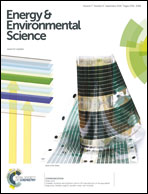Retarding the crystallization of PbI2 for highly reproducible planar-structured perovskite solar cells via sequential deposition†
Abstract
On a planar substrate the sequential deposition of CH3NH3PbI3 perovskite is optimized by retarding the crystallization of PbI2. This strategy overcomes the problem of incomplete conversion and uncontrolled particle sizes of perovskite in the absence of mesoporous scaffolds, greatly increasing the film reproducibility. Highly efficient and reproducible planar-structured perovskite solar cells were obtained with the best efficiency of 13.5%, average efficiency of 12.5% and a small standard deviation of 0.57 from a total of 120 cells.


 Please wait while we load your content...
Please wait while we load your content...